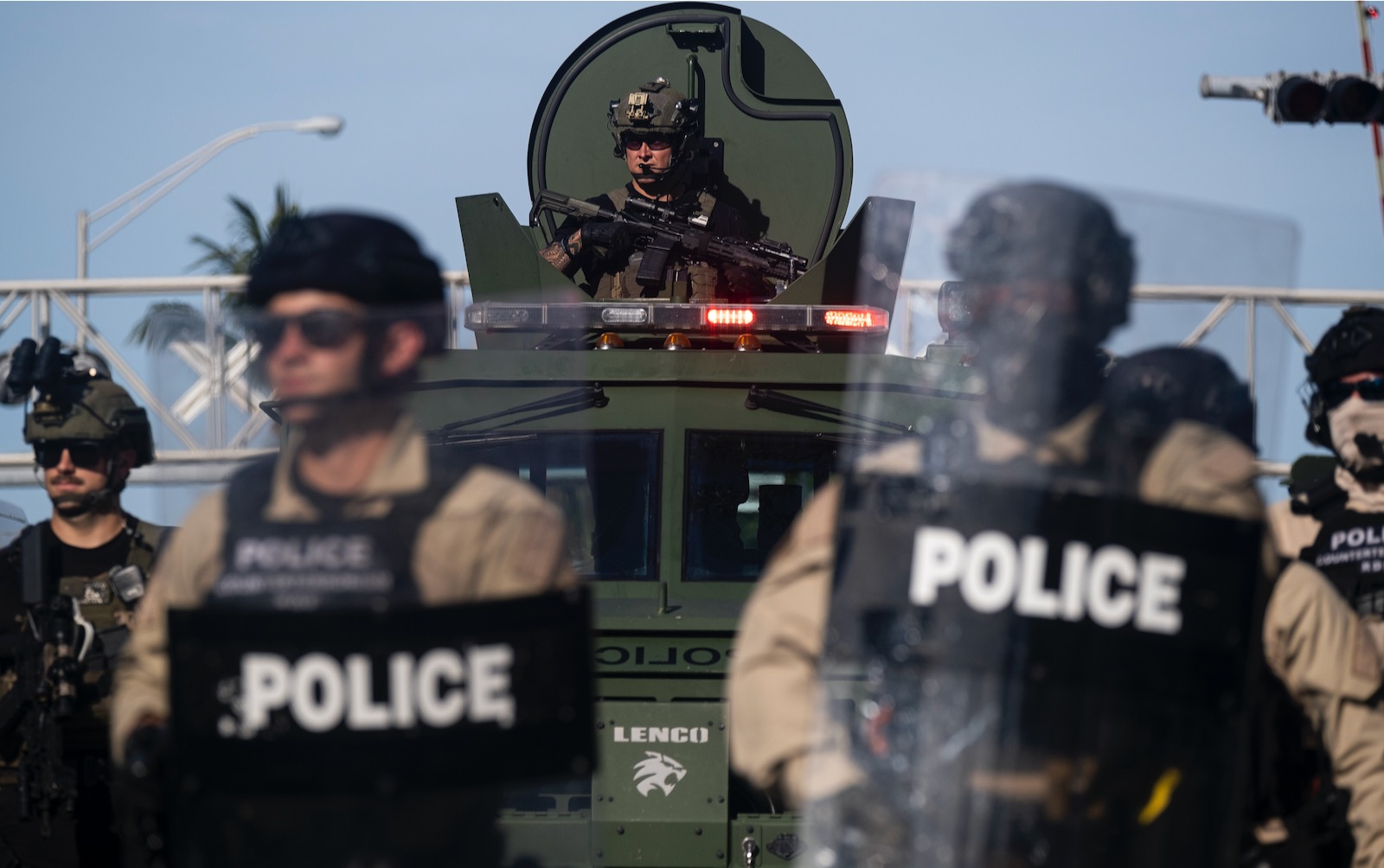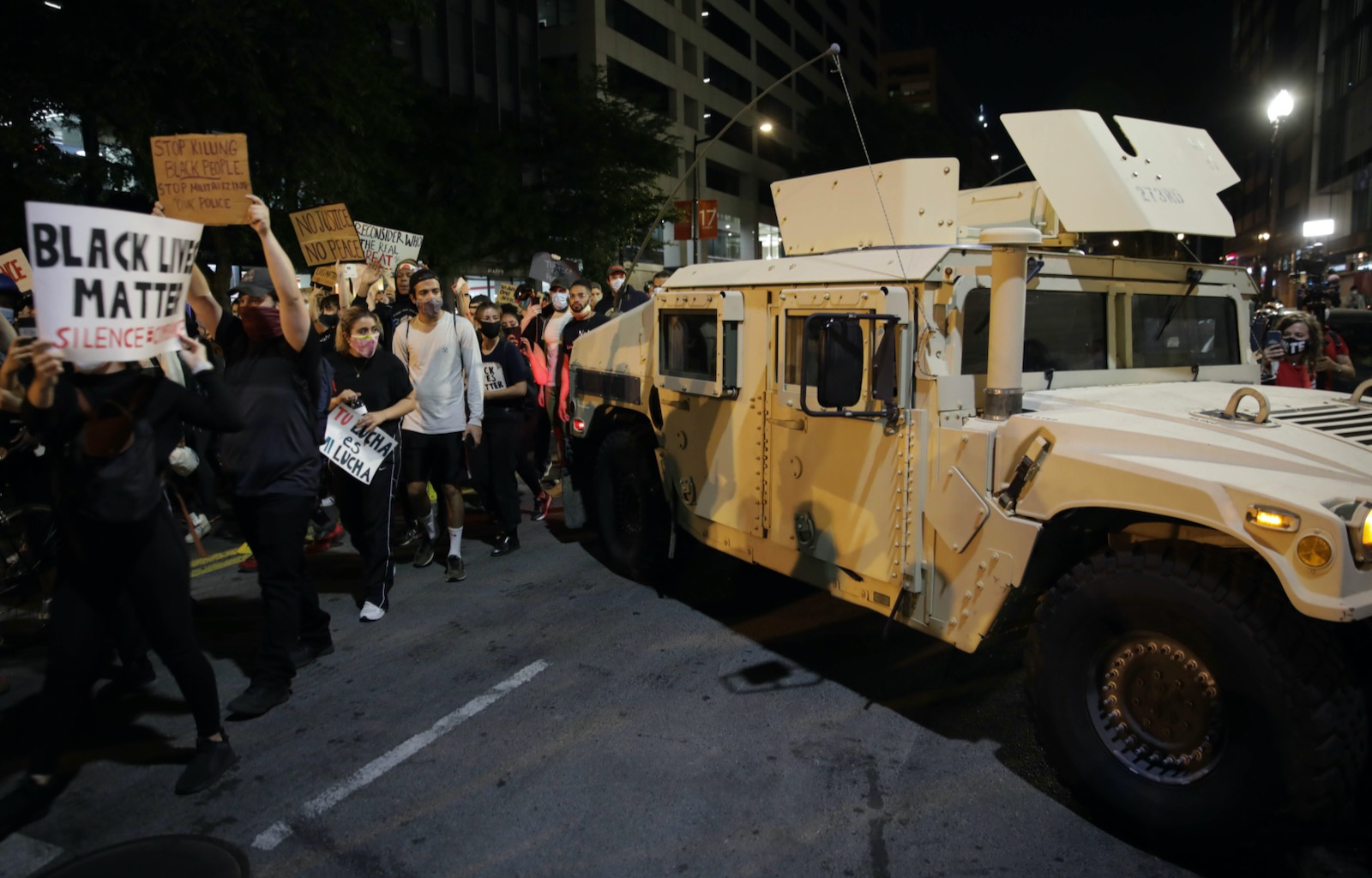Military might has always paraded in America’s streets. But it wasn’t until this century that it became an often daily presence. In the 2000s, local law enforcement agencies began to adopt the type of military equipment more frequently used in a war zone: everything from armored personnel carriers and tanks, with 360-degree rotating machine gun turrets, to grenade launchers, drones, assault weapons, and more. Today, billions of dollars’ worth of military equipment—most used, some new—has been transferred to civilian police departments. As the ACLU has documented, this has led to the militarization of American policing.
It is now commonplace to see a Mine-Resistant Ambush-Protected vehicle, or MRAP, respond to the protests in Minneapolis, Seattle, Los Angeles, and Philadelphia. MRAPs resemble Humvees but are even larger, more heavily armored—and more intimidating. Many police forces acquired them free-of-charge from the Pentagon as part of a program established by the National Defense Authorization Act under President Clinton that transfers surplus equipment—or “excess property,” as it’s called—from combat deployments to police departments across the US.
This Defense Department initiative, known as the 1033 program, requires that law enforcement agencies make use of such equipment within a year of acquisition, effectively mandating that police put it into practice in the public space. The Department of Homeland Security also has a terrorism grant program that has given tens of billions of taxpayer dollars to local police forces to purchase military equipment directly.
There have been efforts in Washington to scale back the Pentagon program in particular. On Capitol Hill, Senators Brian Schatz (Democrat of Hawaii) and Rand Paul (Republican of Kentucky) have repeatedly introduced a bipartisan bill, known as the Stop Militarizing Our Law Enforcement Act, in multiple congresses; Representative Hank Johnson, Democrat of Georgia, has made numerous similar bipartisan efforts in the House. In 2015, President Obama did put restrictions on what could be transferred by the Pentagon from war zone to police forces, weeding out some of the most excessive weaponry. His executive order prohibited, for example, tracked armored vehicles with ballistic protection, weaponized aircraft, vessels, and vehicles, as well as grenade launchers and bayonets. Wheeled armored vehicles, like the MRAPs, faced some controls but were still permitted, along with unfettered access to specialized firearms and ammunition, explosives and riot shields and helmets.
None of these efforts, however, seem to have stemmed the militarization of policing. In his first year in office, President Trump reversed the Obama administration’s restrictions, at then Attorney General Jeff Sessions’s behest. Neither of the Senate and House bills have yet to receive a majority vote and become law.
*
That beat cops so often look like troops is not just a problem of “optics.” There is, in fact, a “positive and statistically significant relationship between 1033 transfers and fatalities from officer-involved shootings,” according to recent research. In other words, the more militarized we allow law enforcement agents to become, the more likely officers are to use lethal violence against citizens: civilian deaths have been found to increase by about 130 percent when police forces acquire significantly more military equipment.
The corollary of more police-involved killings, of course, is more protests in response. That sets up, for some, a convenient “law and order” pretext to occupy American streets—or “dominate” them as President Trump remarked in a recent news conference. That call was echoed by his defense secretary, Mark Esper, who called on governors to “dominate the battlespace” in response to the George Floyd protests across the states.
Law enforcement has, in fact, been training for a moment like this—specifically by learning techniques and tactics from Israeli military services. As Amnesty International has documented, law enforcement officials from as far afield as Florida, New Jersey, Pennsylvania, California, Arizona, Connecticut, New York, Maryland, Massachusetts, North Carolina, Georgia, Washington state, and the D.C. Capitol have traveled to Israel for such training. These programs, according to research backed by Jewish Voice for Peace, focus on exchanging methods of “mass surveillance, racial profiling, and suppression of protest and dissent.” The 2018 report has prompted some cities, such as Durham, North Carolina, to oppose police training with Israeli security partners because of concerns about “subsequent harms to communities of color” in the US.
One might imagine that there were appropriate checks and balances in place to establish guidelines and guardrails for this militarizing of US law enforcement. Yet the culture at the Departments of Defense and Homeland Security, which for years were impossible to audit by the Government Accountability Office (GAO), appears antagonistic to oversight. It’s hard to keep a publicly-funded program like 1033 accountable to the public if citizens are unaware of the program—and the Pentagon has largely succeeded at fending off auditing: there have only been two, in 2018 and 2019, and the agency failed both of them on compliance, inventory accuracy, and accounting issues. According to a survey by the Pentagon-affiliated think tank, the RAND Corporation, roughly half of respondents, or 48 percent, are unaware of programs that provide law enforcement agencies with surplus military equipment.
Advertisement
In an effort to keep the 1033 program accountable, the GAO went so far as to initiate in 2017 an undercover sting operation, creating a fake law enforcement agency that was able to acquire more than a million dollars’ worth of military equipment. Aside from the waste, fraud, and abuse this exposed, the episode showed how low the barriers are and how serious the lack of accountability is with the Pentagon program’s supply of matériel to the thousands of law enforcement agencies across America.
*
Military hardware not only makes civilian cops look like soldiers; it makes them more likely to act like soldiers, too. Wall Street Journal reporter Radley Balko’s work documenting the rise of the “warrior cop” is indispensable: he has showed how this warrior mentality, which gained momentum thanks to no-knock Drug Enforcement Agency home raids, leads to the dangerous othering of civilian “targets.” As the mindset has crept into more and more police departments, the inevitable consequence is fatal incidents like the one that occurred in March, when Louisville police shot to death twenty-six-year-old Breonna Taylor in just such a no-knock raid.
Add to these influences the fact that communities of color in most major American cities are still being policed by white officers, many of whom don’t live in the community they’re policing, and the stage is set for conflict and excessive use of force. The racial disparities that exist throughout the law enforcement system lead, unsurprisingly, to low levels of trust for police among communities of color.
The sort of policing responses to protest seen in many cities across the US these past two weeks has to be understood as the result of law enforcement agencies’ preparation to act as a paramilitary force in public space redefined as a war zone. Of course, the federal government could step in to stop this increased militarization at its source. The Pentagon could end its transfer of military-grade weapons through the 1033 program. The Department of Homeland Security could stop handing out the terrorism grants. But it’s hard to see this happening without bipartisan legislation in both halls of Congress forcing President Trump’s hand with a veto-proof majority.
Even if half of Americans are unaware of how their police have been militarized, and some further fraction of the population has come to accept it as simply the new normal, foreign observers do see how aberrant and menacing the situation is. The European press has denounced and decried the Trump administration’s tactics, with one German newspaper noting that “Trump Declares War on America.”
The Black Lives Matter movement is calling for the divestment and defunding of national police forces, a petition that is quickly picking up steam. But the work of disarming, demobilizing, and reintegrating the law enforcement combatants will have to take place at a local level—between citizens and the police who are charged with protecting public safety—while recognizing how vastly different various communities’ experiences of the police are. That in turn must lead to a recognition of the vastly different points of view about the need for reform, up to and including abolition.
The good news is that in some places police and protesters are talking to each other—without riot gear and without MRAPs and assault weapons drawn. In Fort Worth, police were shaking hands and hugging protesters. In Portland, police and demonstrators took a knee together in a show of solidarity—though some have argued that after the taking-a-knee photo op, police returned to escalating violence. In Atlanta, the police chief was on the streets talking to protesters, sharing her view that what had happened in Minneapolis was absolutely unacceptable. In several US cities, police officers are joining protesters for prayers.
These may feel like small, easily dismissed instances, but such small acts of solidarity are where a de-escalation—and, ultimately, the disarmament of American policing—must begin. But let’s acknowledge where one of the greatest obstacles to reform lies: individual officers of good will need to go beyond showing solidarity with protesters at marches and engage in efforts to reform their departments from within.



